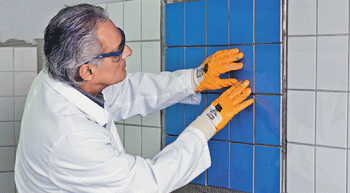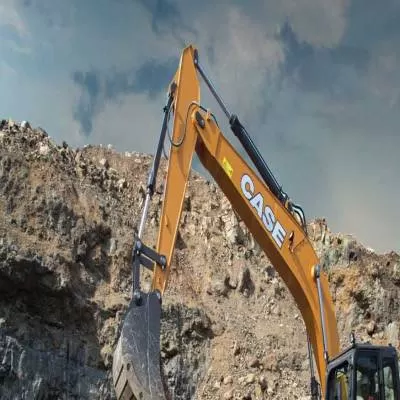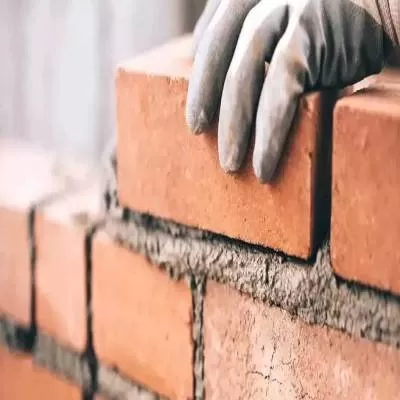- Home
- Building Material
- Cement
- Bind it!

Bind it!
In the past, many materials have been introduced in the market to ease the construction process. Dispersible polymer powders are among them, offering increased flexibility and better weathering resistance along with a longer end-product service life. Saulat Khan, Business Head, Construction Polymers India, Wacker Chemie India, shares with CW the importance of this material by providing some live examples.
The process
Dispersible polymer powders are binders based on vinyl acetate and ethylene produced by spray drying dispersions. Liquid dispersions are made of water and tiny, finely distributed polymer particles ranging between 0.1 ¦m and 5 ¦m in size. To obtain the powder, the water is removed from the dispersions in large dryers.
Spray drying causes many individual dispersion particles to clump together into dispersion powder grains of ca100 ¦m. An anti-blocking agent is added to prevent the particles sticking together during storage. As soon as the dispersible polymer powder comes into contact with water, it disintegrates, releasing the individual particles again. The dispersed polymer powder has the same properties as the original dispersion - creating binders ideal for building. In the hardened cement, the polymer particles form bridges to the substrate, thus improving the adhesion of the mixed mortar to the substrate.
Uses and applications
Dispersible polymer powders are mainly used in construction. Here, the choice of binders plays a key role as they determine the essential performance and processing properties of building materials. They enable high-quality mineral building materials with precisely defined technical properties, and thus open up many applications and techniques. Plus, polymeric binders help rationalise construction-site processing. A good example of the benefits of modern, dispersible polymer powders is polymer-modified tile adhesives. With the so-called thin-bed technique, much less adhesive is needed, which cuts costs substantially. In the past, about 10 kg of mortar-based tile adhesive was needed per sq m and the tiles had to be laboriously fixed in position. Now, only about 3 kg of dry mortar containing polymer powders are required. Professional tilers have the advantage of being able to work considerably faster with little to no risk to faulter. Particularly in modern construction units such as skyscrapers, polymer powders binders prove beneficial as they reduce the overall weight of such buildings and hence have a positive impact on the steel frame and foundations.
Live examples
Another example of the useful properties of polymer powders are external thermal insulation composite systems (ETICS) as a simple and reliable method of conserving energy. The better a building is insulated, the less energy is needed, regardless of whether the building needs to be heated or cooled.
A major component of the mortars used in modern, high-quality ETICS are polymer binders as they ensure that the individual layers of the system are bonded together permanently. Similarly, it was the use of polymer binders that first permitted the development of self-levelling floor screeds. These products primarily serve to prepare floors in readiness for the final floor covering. For this application, uniform absorbency, good adhesion and the capability to smooth irregularities are of great importance. Like polymer-modified tile adhesives, these compounds, too, are characterised by rapid setting and drying, which happens virtually overnight.
Waterproof sealing slurries are based on polymer binders as well. Because they are easy to use, the slurries are a sure form of protecting a large number of buildings from water damage. The slurries not only prevent damage caused by water ingress but help save water. Impregnated water channels and reservoirs, for instance, prevent water loss, thus promoting the efficient and sustainable use of water.
In India, in a majority of buildings, putties are applied in the interior before decorative coatings. One of the most widely used applications of dispersible polymer powder is white cement-based polymer-modified putty, also known as skim coat. Dispersible polymer powder forms a film in the cement matrix and thus provides excellent adhesion onto the applied substrate. Depending on the type of polymers used, it bestows excellent hydrophobicity on the putty, reducing dampness while not reducing surface breathability, thus minimising the chance of blistering and flaking of the putty. It also imparts high abrasion resistance to the surface resulting in a smooth base coat for the final coating application. Further applications include coatings, plasters, concrete or infrastructure applications. Some international projects in which it is used include the Bird´s Nest Olympic Stadium in Beijing, the Cairo Television Tower and the Estadio Beira-Rio soccer stadium in southern Brazil.
The right mix
The use of dispersible polymer powder depends strongly on its application. For instance, a small amount of dispersible polymer powder in the mortar is enough to bond the various layers of an exterior insulation system permanently and reliably together - but without polymeric binder, the system may just fall off the wall. In tile adhesives, the so-called thin-bed technique of laying tiles makes it a lot more efficient and cost-effective, but it would be impossible without dispersible polymer powders. Hence, depending on the application, the dosage can range from 2 per cent to 30 per cent of the total dry-mix weight.
Bonus points
- It provides the mortar with its precisely defined properties, including improved workability, good adhesion to all substrates, increased flexibility and better weathering resistance, which also result in a longer end-product service life.
- It enables a broader range of applications for products such as tile adhesives that enable the installation of tiles on tiles, tiles on wood, etc, simply because such specialty mortars are tailored to modern construction techniques that cannot be produced on site.
- It enables more efficient construction methods, for instance, using easy-to-process self-levelling compounds to produce flooring that one can walk on in almost no time.
- It leads to lower material consumption and reduced waste, which means reduced environmental impact. And as it is free of coalescing agents and has low emissions, it offers a favourable eco-balance.
- It offers a high degree of application safety, reliability and higher processing reliability by using ready-mixed dry-mix mortar grades, avoiding job site mixing errors even by usage from unskilled labour.
- It is easy to transport and store, resulting in reduced transport and handling costs.
- It enables new building solutions, such as waterproofing membranes for long-lasting protection against water damage.
Lifecycle and availability
The expiry date of dispersible polymer powders is six months. However, their properties remains intact when kept as advised. This material is easily available in India. Indeed, it´s now time to bind construction projects with dispersible polymer powders!
- Construction
- Dispersible Polymer Powders
- Binders
- Building Materials
- Saulat Khan
- Construction Polymers India
- Wacker Chemie India
- Liquid dispersions
- Powder
- Water
- Spray drying
- Hardened Cement
- ETICS
- Putty
- Coating
- Birds Nest Olympic Stadium
- Beijing
- the Cairo Television Tower
- Estadio Beira-Rio soccer stadium
- Exterior Insulation System
- Tiles
- Wood
Used in construction, dispersible polymer powders are binders that determine the essential performance and processing properties of building materials. In the past, many materials have been introduced in the market to ease the construction process. Dispersible polymer powders are among them, offering increased flexibility and better weathering resistance along with a longer end-product service life. Saulat Khan, Business Head, Construction Polymers India, Wacker Chemie India, shares with CW the importance of this material by providing some live examples. The process Dispersible polymer powders are binders based on vinyl acetate and ethylene produced by spray drying dispersions. Liquid dispersions are made of water and tiny, finely distributed polymer particles ranging between 0.1 ¦m and 5 ¦m in size. To obtain the powder, the water is removed from the dispersions in large dryers. Spray drying causes many individual dispersion particles to clump together into dispersion powder grains of ca100 ¦m. An anti-blocking agent is added to prevent the particles sticking together during storage. As soon as the dispersible polymer powder comes into contact with water, it disintegrates, releasing the individual particles again. The dispersed polymer powder has the same properties as the original dispersion - creating binders ideal for building. In the hardened cement, the polymer particles form bridges to the substrate, thus improving the adhesion of the mixed mortar to the substrate. Uses and applications Dispersible polymer powders are mainly used in construction. Here, the choice of binders plays a key role as they determine the essential performance and processing properties of building materials. They enable high-quality mineral building materials with precisely defined technical properties, and thus open up many applications and techniques. Plus, polymeric binders help rationalise construction-site processing. A good example of the benefits of modern, dispersible polymer powders is polymer-modified tile adhesives. With the so-called thin-bed technique, much less adhesive is needed, which cuts costs substantially. In the past, about 10 kg of mortar-based tile adhesive was needed per sq m and the tiles had to be laboriously fixed in position. Now, only about 3 kg of dry mortar containing polymer powders are required. Professional tilers have the advantage of being able to work considerably faster with little to no risk to faulter. Particularly in modern construction units such as skyscrapers, polymer powders binders prove beneficial as they reduce the overall weight of such buildings and hence have a positive impact on the steel frame and foundations. Live examples Another example of the useful properties of polymer powders are external thermal insulation composite systems (ETICS) as a simple and reliable method of conserving energy. The better a building is insulated, the less energy is needed, regardless of whether the building needs to be heated or cooled. A major component of the mortars used in modern, high-quality ETICS are polymer binders as they ensure that the individual layers of the system are bonded together permanently. Similarly, it was the use of polymer binders that first permitted the development of self-levelling floor screeds. These products primarily serve to prepare floors in readiness for the final floor covering. For this application, uniform absorbency, good adhesion and the capability to smooth irregularities are of great importance. Like polymer-modified tile adhesives, these compounds, too, are characterised by rapid setting and drying, which happens virtually overnight. Waterproof sealing slurries are based on polymer binders as well. Because they are easy to use, the slurries are a sure form of protecting a large number of buildings from water damage. The slurries not only prevent damage caused by water ingress but help save water. Impregnated water channels and reservoirs, for instance, prevent water loss, thus promoting the efficient and sustainable use of water. In India, in a majority of buildings, putties are applied in the interior before decorative coatings. One of the most widely used applications of dispersible polymer powder is white cement-based polymer-modified putty, also known as skim coat. Dispersible polymer powder forms a film in the cement matrix and thus provides excellent adhesion onto the applied substrate. Depending on the type of polymers used, it bestows excellent hydrophobicity on the putty, reducing dampness while not reducing surface breathability, thus minimising the chance of blistering and flaking of the putty. It also imparts high abrasion resistance to the surface resulting in a smooth base coat for the final coating application. Further applications include coatings, plasters, concrete or infrastructure applications. Some international projects in which it is used include the Bird´s Nest Olympic Stadium in Beijing, the Cairo Television Tower and the Estadio Beira-Rio soccer stadium in southern Brazil. The right mix The use of dispersible polymer powder depends strongly on its application. For instance, a small amount of dispersible polymer powder in the mortar is enough to bond the various layers of an exterior insulation system permanently and reliably together - but without polymeric binder, the system may just fall off the wall. In tile adhesives, the so-called thin-bed technique of laying tiles makes it a lot more efficient and cost-effective, but it would be impossible without dispersible polymer powders. Hence, depending on the application, the dosage can range from 2 per cent to 30 per cent of the total dry-mix weight. Bonus points It provides the mortar with its precisely defined properties, including improved workability, good adhesion to all substrates, increased flexibility and better weathering resistance, which also result in a longer end-product service life. It enables a broader range of applications for products such as tile adhesives that enable the installation of tiles on tiles, tiles on wood, etc, simply because such specialty mortars are tailored to modern construction techniques that cannot be produced on site. It enables more efficient construction methods, for instance, using easy-to-process self-levelling compounds to produce flooring that one can walk on in almost no time. It leads to lower material consumption and reduced waste, which means reduced environmental impact. And as it is free of coalescing agents and has low emissions, it offers a favourable eco-balance. It offers a high degree of application safety, reliability and higher processing reliability by using ready-mixed dry-mix mortar grades, avoiding job site mixing errors even by usage from unskilled labour. It is easy to transport and store, resulting in reduced transport and handling costs. It enables new building solutions, such as waterproofing membranes for long-lasting protection against water damage. Lifecycle and availability The expiry date of dispersible polymer powders is six months. However, their properties remains intact when kept as advised. This material is easily available in India. Indeed, it´s now time to bind construction projects with dispersible polymer powders!























